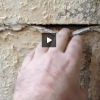Apart from sealing the outside wall with sealants such as tar and vinyl coatings, the approach of grading the land outside away from the house is the most common approach to waterproofing basements. This is a logical and often an affordable approach of a few conditions exist:
1. Shallow basements next to lower ground.
Simply put: Your basement floor is only 2-4 feet underground and your yard slopes away from your house in such a way that the ground actually lowers to a level that is considerable lower than your basement floor. Under this scenario you could dig a drainage pit to the depth of the wall/footer across the foundation wall and then run the drainage to a place lower than your basement floor. Drains need to be quite substantial and installed with 6-10 inches of rock filter fabric underneath as well as fabric and rock above (at least a foot) to ensure the drains will not clog. The drainage needs a reasonable pitch: 2/12 or more.
No pitch. No drainage.
No lower ground. No drainage.
Period.
2. Shallow basements near a storm or other drain that you can attach to.
This is the same as above the only difference being that you would be attaching your drainage pipe to a preexisting drain. You should ascertain the guaranteed flow of the drain you will be attaching to. If it backs up “only in heavy rains” this will not do. You will really need this drain mainly “only in heavy rains”. This is a ver common mistake made when people connect their gutter to underground drains that clog easily in heavy rains.
Sometimes these drains belong to either the city or to your neighborhood association etc. If so you will need their permission to drain to it.
You may have noticed that grading alone is not mention. Grading is only considered a practical waterproofing measure under certain specific circumstances. Read about grading.

